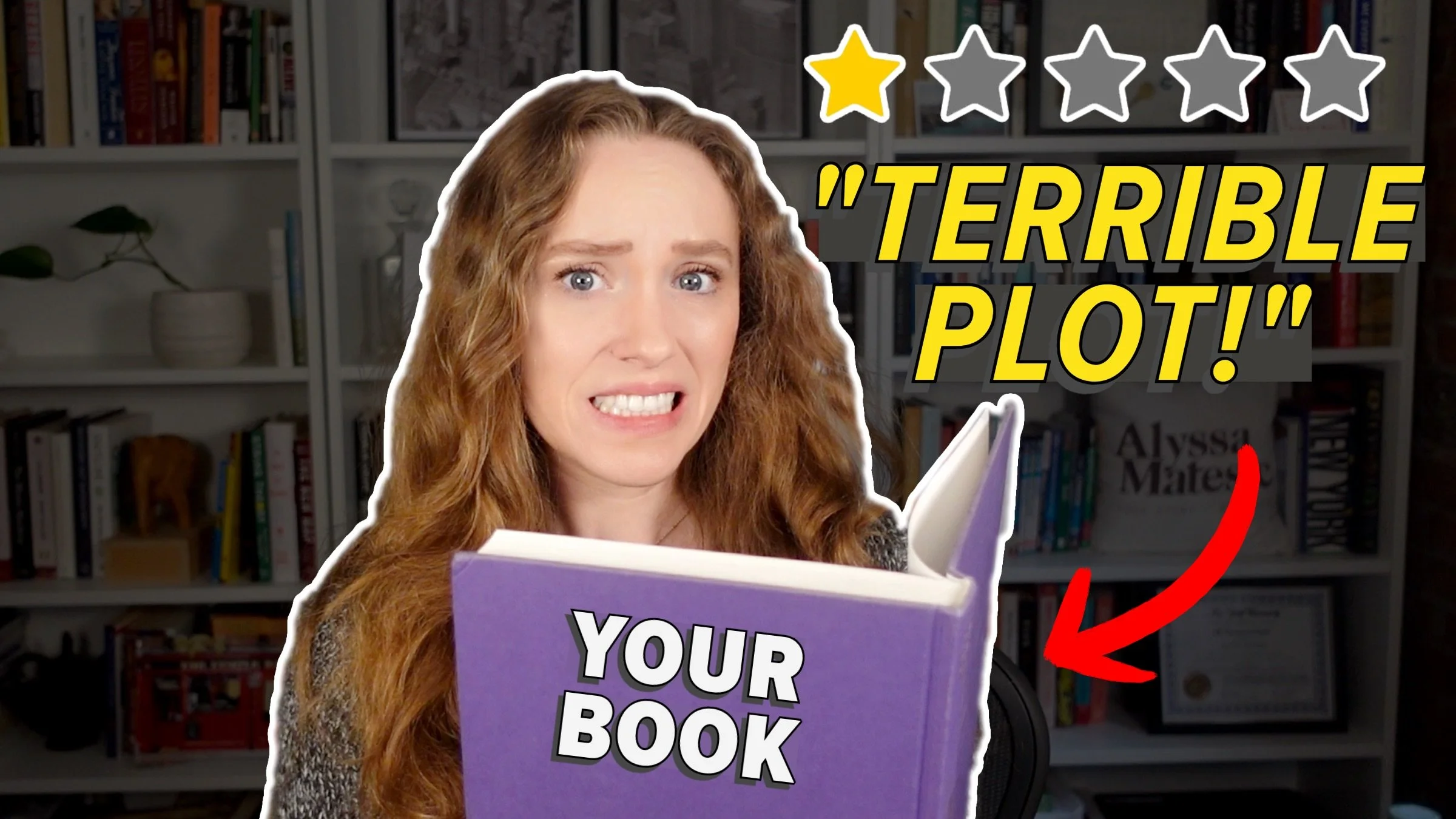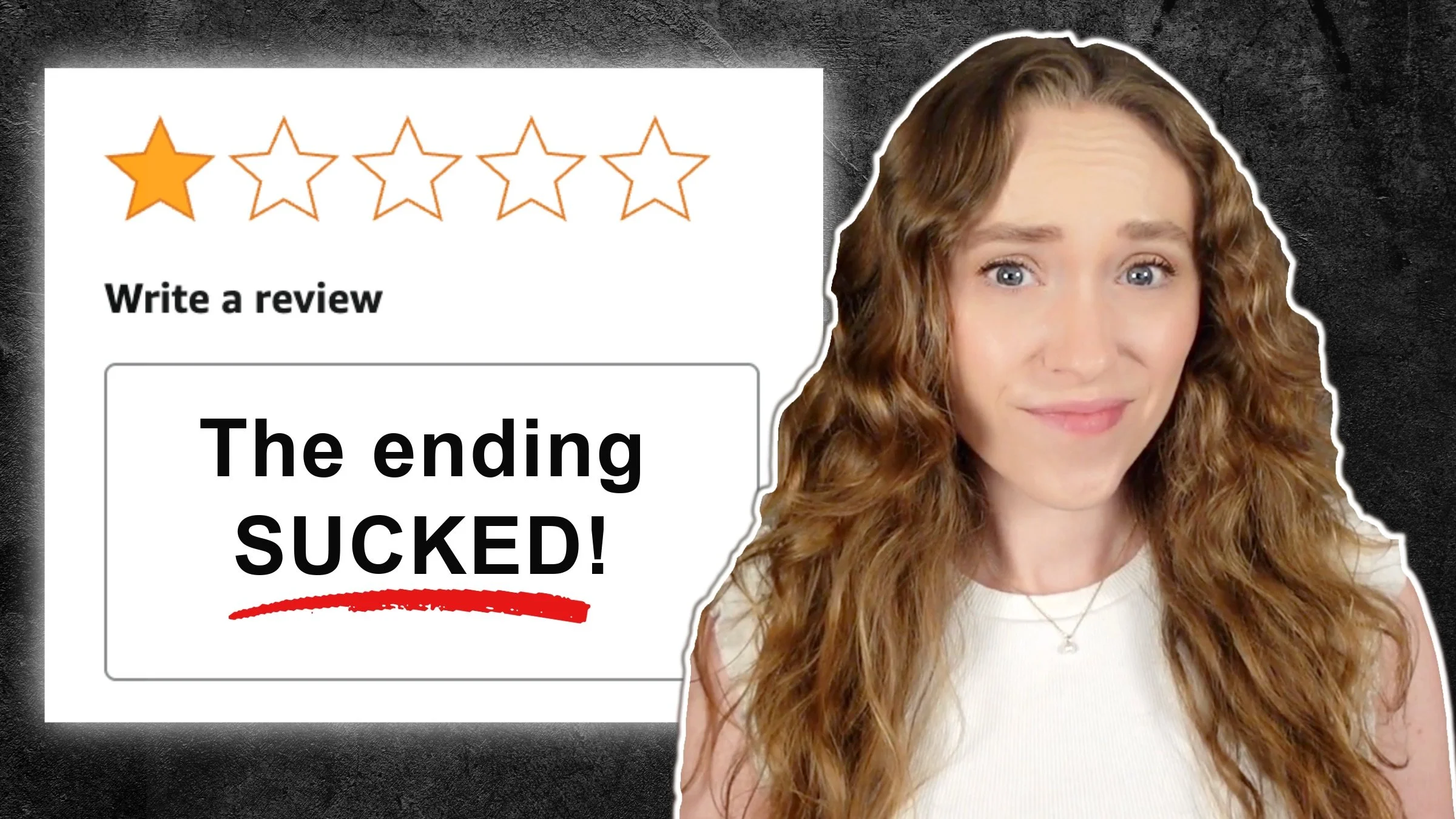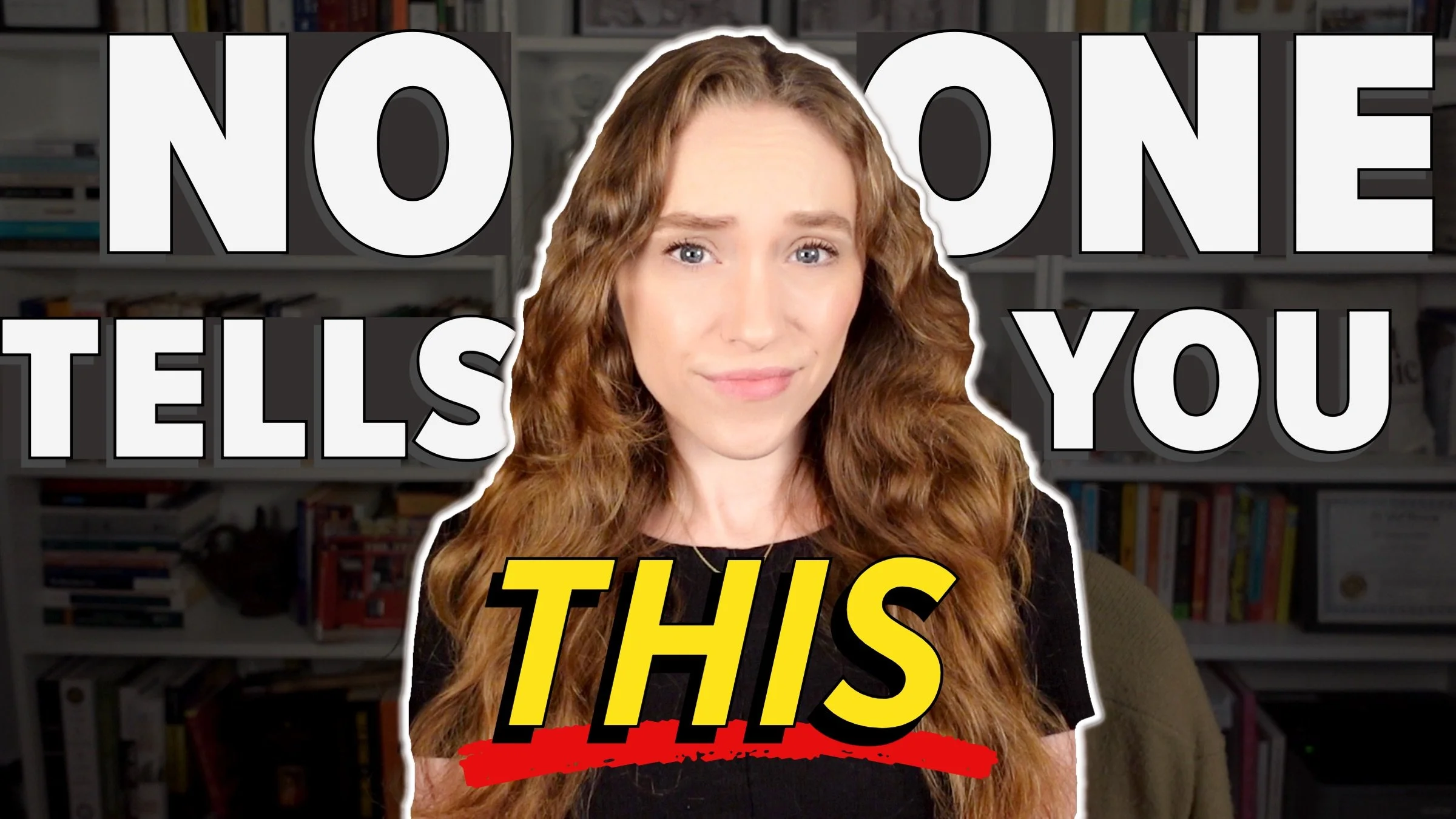7 Major Plot Mistakes To Avoid
HIT PLAY OR READ THE POST BELOW:
You could have the most beautiful writing in the entire world, but if your plot is broken, your reader will bail faster than a bookworm at a karaoke bar.
As a developmental book editor who’s worked with hundreds of authors — from debut novelists to New York Times best-selling authors — it’s my job to help writers fix the broken parts of their stories, and nine times out of ten, the manuscript I’m editing will have a significant plot issue. So here are seven plot mistakes that might secretly be killing your story — and exactly how to fix each one.
1. A Slow Start
This plot mistake causes readers to put your story down before it even really gets going — and sabotages your chances with literary agents and publishers.
I’m not saying an explosion needs to happen on page one (unless you’re writing an action-packed thriller where that makes sense) but something does need to happen in your opening to give readers a reason to continue on with the story. Identify the moment where life changes forever for your protagonist. That’s the inciting incident, and it should occur early in your story.
Think of it as that first domino that tips over and sets the plot in motion — it’s when Katniss volunteers as tribute, when Bilbo Baggins gives Frodo the ring, when Nemo is captured by scuba divers. Typically, the inciting incident should happen between 10 to 15% of the way through your novel, though sometimes it happens as early as chapter one.
Unfortunately, when editing my clients’ manuscripts, I often find the first 50 or so pages are treated more like a warm-up — the author’s establishing the setting, describing the protagonist’s mundane daily routine, or delivering lengthy backstory or flashback passages. This sluggish start can be deadly for your story and lead readers to DNF your book. And if you’re querying literary agents, this mistake could lead them to reject your manuscript — because they will only read as much as interests them. If nothing happens in the first pages to keep them hooked, they’ll pass and move on.
So here’s how to fix a slow start:
First, identify your inciting incident. See where it occurs in your draft — is it within that 10 to 15% sweet spot (or earlier)? Or does it come later than that? If it’s later, trace backward and determine what the reader truly needs to know before that inciting incident. Trim everything except the minimum setup needed.
You’ll often find that a lot of that early material wasn’t actually necessary — and could be incorporated later in the story or taken out entirely.
2. Convenient Discoveries
I get it. Sometimes you just need to get your character from point A to point B, so you throw together a solution that you know isn’t the most creative or believable: they find a diary that reveals a major secret about another character, they happen to open a drawer that contains a treasure map, they coincidentally run into a wise old man who holds all the answers.
But if your characters always seem to find exactly what they need exactly when they need it, your reader will notice — and not in a good way. Yes, fiction demands some coincidences and conveniences sometimes, but when it happens over and over and over again, it erodes the believability of your story and breaks the reader’s trust.
The key is to limit these convenient discoveries so they don’t feel like lazy storytelling. Audit your manuscript and find every lucky break. Then ask yourself: could this discovery be earned rather than coincidental?
Instead of happening to open the right drawer, perhaps your protagonist overhears a conversation about a treasure map, then pieces together clues and strategically determines where they could find it. Making your character work to discover information is almost always more compelling and interesting than the solution falling into their lap.
To be sure, readers don’t mind a little bit of narrative luck here and there — but convenient discoveries should be the exception, not the default way the plot moves forward.
3. Runaway Train
This is when your plot pivots away from the main drama to something else entirely: a secondary character’s tragic backstory, a new POV we haven’t been introduced to yet (even though we’re deep into the story already), or exposition that’s really just an info dump of nitty-gritty worldbuilding details we don’t really need. These scenes ultimately feel like unnecessary tangents and diminish all the narrative momentum you’ve built up to this point.
If your reader starts to sense that your plot is veering off course, they’ll skim through those sections until it feels like we’ve reentered the main drama. And if it feels like the story has spiraled out of control and lost all direction, they’ll put down the book entirely.
To make sure your plot doesn’t become a runaway train, evaluate each subplot critically. Ask: “Does this directly complicate or contribute to the protagonist’s journey?” Remember — that’s what the reader is invested in, first and foremost. Don’t derail the protagonist’s journey for a side quest nobody asked for.
More backstory, more subplots, and more worldbuilding doesn’t necessarily make your story more layered and complex — it could just be creating more noise. A strong plot is streamlined and focused, where every scene, every subplot, and every moment is building organically toward the climax and serves a function.
4. Deflating balloon
Ever read a line like this? “The next month passed by in a blur.” Or “Two weeks later, there were still no new developments in the case.” Or worse yet, “For the next six months, life was great.” The second your story flatlines like this, your reader mentally checks out.
Yes, sometimes your characters need time to regroup, heal, or reflect — but you want to eliminate as much dead space in your story as possible. If you have a series of time jumps where nothing is really happening, the tension in your story will fizzle out like a deflating balloon.
Oftentimes, fixing these lulls in your plot means perfecting your pacing and condensing the narrative timeline. Rather than having a two-week break where nothing happens, why not make that next plot development happen the very next day? If you can’t tighten up the timeline for a logistical reason, then use that time to develop a subplot — like a romance or a complicated family dynamic.
Your plot should never feel like things are coasting or totally resolved. If no progress is being made — or if your protagonist is content with things as they are — then you give the reader no reason to continue on with the story.
Your plot must always have tension — something unresolved that keeps us interested. Every scene should complicate things further, not maintain the status quo. Because when the conflict deflates like a balloon, your reader will float away with it.
5. Bait-and-Switch
This happens when the first half of your story sets up a promise to the reader that’s broken in the second half because it pivots to something else entirely. For example, the first half of your story follows your protagonist in high school, and their primary concern is figuring out how to ask their crush to prom. It reads like a YA romcom — but then halfway through, we fast-forward 30 years and now follow the protagonist’s midlife crisis. You hooked the reader with a teen romance plot, only to pull the rug out from under them when that’s not what the story ends up focusing on.
This bait-and-switch issue often happens when you have a major timeline or POV shift partway through the story. Suddenly, we’re following a completely different set of circumstances — and sometimes a completely different set of characters. I’m not saying it can never work to have a big timeline or perspective shift midway through your story, but if you’re structuring it this way, proceed with caution.
Brainstorm ways to ensure the entire narrative experience feels cohesive. Are those two halves really telling the same story? If not, you have two options. Option one is to restructure the story so that you switch between those perspectives or timelines from the beginning, and they progress in parallel. Option two would be to cut one of the storylines entirely and reframe the story to only follow the other. Perhaps that other storyline was really just backstory — or even another novel entirely.
Your early scenes set the reader’s expectations for who the story will follow and what the primary conflict will entail. Whatever you present first is what they’re going to become invested in — so if you pivot away from that, you’ll lose their attention.
6. Messy Middle
Even if you absolutely nail the beginning of your novel, if the middle portion meanders or feels saggy, your story will stagnate. A messy middle happens when the conflict doesn’t steadily escalate leading up to the climax. The protagonist is spinning their wheels, running in place, and the story feels stuck — we don’t know where it’s going.
In an attempt to stick a band-aid on a bad plot, you might lean into some of the other mistakes we’ve talked about today, like convenient discoveries or tangents. But those aren’t ways to fix a messy middle — and will only make it worse.
Rather than diverting the reader’s attention away from the main conflict, you should be digging deeper into it — complicating the protagonist’s journey leading up to the climax. If you have a messy middle, try raising the stakes by introducing a threat bearing down on the protagonist or their loved ones. Or have them face an internal battle that’s preventing them from taking the steps they need. Do they have conflicting priorities pulling them in different directions?
One of my favorite ways to fix a messy middle is to introduce a midpoint twist. This is a major development that reframes the protagonist’s goal and increases the urgency for them to resolve the conflict. It could be a betrayal by another character, or the reveal of a secret that changes everything. It should alter the protagonist’s understanding of their journey — and force them to take immediate action.
A successful midpoint twist will refuel your story with even more narrative momentum.
7. Abrupt Ending
Imagine if The Lion King ended with the scene of the final battle between Simba and Scar — or if Titanic ended just as the ship went down. Where does that leave the hyenas? What ends up happening to Jack and Rose? We’d have no closure.
Without enough falling action after your story’s climax, readers will be left blinking at the page like, “Wait — that’s it?” Use this time to wrap up any loose threads and show how the protagonist has fundamentally changed. What’s different now? Where will they go from here? That’s what delivers a satisfying emotional payoff.
I’m not saying you need to write 100 pages of falling action — but show a scene or two in the aftermath of the climax. Even just one well-written scene can turn a bad book ending into one with a strong sense of resolution and closure.
As you write those scenes, think about what emotional imprint you want to leave on the reader. How should they feel after they finish the final page — inspired? Disturbed? Make sure your closing scenes match the tone of everything that’s come before. That means if a happily ever after or an epilogue that shows all the characters thriving 20 years later doesn’t suit your story — don’t write one. You can still have closure without a traditional happy ending.






